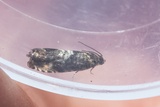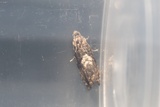Pammene suspectana (Lienig & Zeller, 1846) Species
Last modified: Jan. 12, 2025, 3:18 p.m.
A new species in Belgium in 2020 in LX.
Details
- Classification
- Family: Tortricidae > Subfamily: Olethreutinae > Tribus: Grapholitini > Genus: Pammene > Species: Pammene suspectana
- Vernacular names
- Essendwergbladroller (NL), Ash-bark Piercer, Ash Bark Tortrix (EN)
- First mention in Belgium
- Wullaert S. 2021. Resultaten van de Werkgroep Bladmineerders uit 2019 en 2020 met meldingen van 9 nieuwe soorten voor de Belgische fauna (Elachistidae, Cosmopterigidae, Gelechiidae, Noctuidae, Tineidae en Tortricidae) — Phegea 49(3): 109–124. On page 120. view page
- Status
-
Native
For your information, to the best of our knowledge, the first 5 Belgian observations are listed here:
1) 1 ♂ on 02.viii.2020 at Torgny (LX), leg. Werkgroep Bladmineerders, gen. det. S. Wullaert. (on MV light)
2) 1 ♂ on 10.v.2021 at Plombières (LG), leg. Werkgroep Bladmineerders, gen. det. S. Wullaert. (on pheromone G. molesta)
3) 1 ♂ on 24.v.2021 at Fescaux (NA), leg. Werkgroep Bladmineerders, gen. det. S. Wullaert. (on pheromone C. indivisa)
4) 1 ♂ on 12.v.2022 at Deerlijk (WV), leg. R. Recour. (on pheromone G. molesta)
5) 1 ♂ on 04.v.2023 at Deerlijk (WV), leg. R. Recour. (on pheromone G. molesta)
Distribution
Imago
Wingspan 11–13 mm. The most common pheromones lures that attract males are the one originally intended for Cydia indivisa, Grapholita molesta and Grapholita funebrana. These are the most frequent ones.
The moth is similar to several other Pammene species so genital control is necessary to determine this species.
Bionomics
Little is known about biology but the larva is believed to feeds within the bark on the host plant.
The adults come infrequently to light and to pheromone lures.
Flight periods
The adults have been seen from early May towards early August.
Observed on
- Host plant (species):
- Fraxinus excelsior
There is limited information on the early stages but they are thought to be associated with Fraxinus excelsior.
Habitat
It inhabits parkland and woodland.


